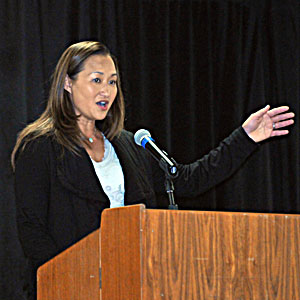Pearl Sinn-Bonanni was a youth phenom and college star in golf in the 1980s. She attended Arizona State, which had a women’s golf team before the 1971 passage of Title IX — the education equality legislation — and was a powerhouse program in the sport.

Women in Sports Luncheon speaker Pearl Sinn-Bonanni
Speaking at the Santa Barbara Athletic Round Table’s annual Women in Sports Luncheon at the Earl Warren Showgrounds, Sinn-Bonanni, now the women’s golf coach at Cal State Fullerton, said the women’s golfers at ASU were treated like celebrities in the local community.
It wasn’t until she turned professional that she experienced the inequality between women’s and men’s golf.
“Title 9 is great and there’s a lot more equality in the high school and college areas, but it still had a long way to go,” she said. “I see now, looking back, we still have a lot of work to do.”
Sinn-Bonanni used professional golf as an example.
“The guys on the PGA Tour probably make 10 times more money than a female makes on the LPGA Tour,” she said. “I know it’s a little different — professional sports is different, it’s a free market out there. If you can bring in an audience, you’ll make more money. There are millionaires on the PGA Tour. If you’re not top 20 on the women’s tour, you’re going to have a tough time making a living.”
Sinn-Bonanni, who played in more than 100 LPGA Tour events and retired from the tour in 2005, said she was fortunate to make a living playing golf “because I had a good amateur career and good sponsors.”
She was the U.S. Women’s Amateur champion in 1988 and captured in the U.S. Public Links title in 1988 and ’89, making her the first golfer to win both national titles in the same year.
She said the prize money gap in pro golf is closing but there is still a long way to go.
Asking what it will take to further close the gap in women’s and men’s pro sports, Sinn-Bonanni turned to the prep and collegiate female athletes in the room.
“Fortunately, we have a lot of smart people, a lot of people with charisma that have helped us close that gap. But you, as athletes, your job is to make sure you put the best performance out there. That’s your job.
“That was my job as an athlete,” she said. “I had to give it my best, I had to perform at my best; try to improve my skills so when people came out to watch me play, they were entertained, they were wowed, whatever it was.
“You young athletes who have visions of going on and playing in college or professionally, you have duty because the people before you have put in their time and their work to make these opportunities available for you. You have a duty to go out there and do your best.”
Joan Russell Price, a SBART board member and Hall of Famer, noted that female participation in high school athletics has increased dramatically since the passage of Title IX.
“Forty years ago in 1971, one in 27 girls participated in high school sports,” she said. “In 2012, it’s one in three. So I think we’ve made a little progress.”
In a pep talk to the young athletes, Price said, “So I invite all of you to continue to say, we as a country, as a people, are equal and we get the right to do whatever we dream, whether it’s to be an astronaut, or an olympian, or a president …
“So, my call to all of you is to expect nothing less.”
Marty Plourd, the CEO of Community West Bank, related a story on how sports shaped the character and life of his daughter, Leslie.
She was on track to becoming an Olympic-level gymnast, moving from home at age 11 to train in Oklahoma with U.S. national team coach Steve Nuno.
At age 14, she became an elite gymnasts, but injuries forced her to abandon her Olympic dream.
Plourd was worried how the disappointment might affect her.
“I was afraid her identity was so embedded in gymnastics, she’d have a hard time readjusting,” he said. “After a few short weeks, I found I had nothing to worry about. She transferred the disciplines of her athlete achievement into her new life.”
Leslie graduated from high school and college, got married, entered the health care field and is now a registered nurse.
Plourd credits sports with giving his daughter the inner strength to overcome adversity and face life’s obstacles.
“So although I know a winning athlete will take home a trophy and other accolades, it’s just as important to that athlete to be building an inner discipline and strength which can be used for the rest of her life,” he said. “Athlete endeavors teach women how to live their lives with strength, joy and passion within every area. Congratulations to all of you who are learning that.”
